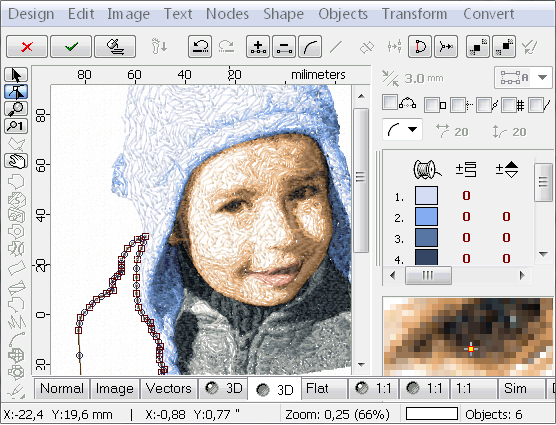Understanding the Needlework Digitizing Refine: Your Ultimate Overview
Embroidery digitizing is a thorough craft that calls for precision and knowledge to translate elaborate layouts right into electronic styles for maker embroidery. As artisans get started on this journey to understand the embroidery digitizing process, an extensive understanding of the fundamentals sets the structure for quality.

Comprehending Embroidery Digitizing Essentials
Needlework digitizing basics create the structure upon which elaborate layouts are equated into machine-readable formats for accurate stitching. This preliminary step in the needlework digitizing process is important for making sure that the final embroidered product is a devoted depiction of the initial layout. Comprehending needlework digitizing basics includes grasping crucial concepts such as stitch types, stitch direction, density, rug, and draw compensation.
Stitch kinds play a vital role in identifying the visual and textural result of the stitched design. By picking the appropriate stitch kind, whether it be satin, fill, or running stitch, digitizers can attain the desired impact and enhance the general high quality of the embroidery. Additionally, stitch direction affects the flow and dimension of the style, while thickness establishes the spacing and insurance coverage of the stitches.
Furthermore, padding stitching offers stability to the layout by securing the textile and avoiding distortion during the needlework procedure. Pull payment is one more crucial consideration to counteract the all-natural tendency of textile to contract when sewn. Understanding these embroidery digitizing fundamentals is essential for developing professional-quality stitched products.
Selecting the Right Digitizing Software
Choosing the proper digitizing software program is a critical decision that significantly impacts the effectiveness and top quality of the embroidery digitizing process. Digitizing for Embroidery. When selecting the appropriate digitizing software program, it is necessary to take into consideration variables such as the intricacy of layouts you plan to produce, the user-friendliness of the software application, the level of client assistance provided, and the compatibility with your embroidery device
There are numerous digitizing software program alternatives offered in the marketplace, varying from standard programs for novices to sophisticated software for expert digitizers. Some prominent selections include Wilcom EmbroideryStudio, Hatch Needlework Software, and PulseID. These software program plans supply a wide variety of tools and attributes to assist you produce complex styles effortlessly.
Before choosing, it is recommended to check out the various software alternatives with totally free tests or demonstrations to establish which one finest matches your demands. In addition, reading reviews and looking for suggestions from seasoned digitizers can provide useful understandings right into the toughness and weaknesses of each software program plan (Digitizing for Embroidery). By thoroughly examining your requirements and contrasting the functions of different digitizing software application, you can make an enlightened selection that improves your embroidery digitizing workflow
Digitizing Devices and Strategies

Optimizing Layout Setup for Embroidery
Understanding the details of design settings is fundamental in attaining ideal outcomes in the embroidery digitizing procedure, structure upon the structure laid by recognizing digitizing tools and strategies. When maximizing style setups for embroidery, it is vital to take into consideration factors such as stitch kind, density, padding, pull payment, and registration. Enrollment settings line up various components of the style precisely, preserving general style stability.

Troubleshooting Common Digitizing Issues
When coming across common digitizing issues throughout the embroidery process, it is vital to comprehend the source and apply reliable solutions quickly. One common trouble is stitch density issues, where stitches may be too dense, triggering the fabric to tighten, or also thin, bring about spaces in the layout. Readjusting the stitch thickness settings in the digitizing software program can assist solve this problem.
Another regular obstacle is thread breaks throughout the needlework process. This can occur because of various reasons such as wrong stress settings, dull needles, or utilizing low-grade thread. Guaranteeing proper maintenance of the needlework equipment, including routine needle adjustments and tension changes, can lessen the incident of thread breaks.
Additionally, style enrollment mistakes can cause misaligned components within the embroidery layout. Checking the style positioning in the digitizing software program and making needed changes before stitching can assist in avoiding this concern. By dealing with these usual digitizing concerns promptly Your Domain Name and effectively, you can guarantee a smoother needlework procedure and premium ended up products.
Verdict
In verdict, mastering the needlework digitizing procedure needs a strong understanding of the basics, the ideal selection of software, and knowledge of devices and methods. Optimizing design settings and repairing typical digitizing issues are crucial steps in ensuring high-quality needlework results. By complying with these steps vigilantly, one can attain accuracy and efficiency in the digitizing procedure.